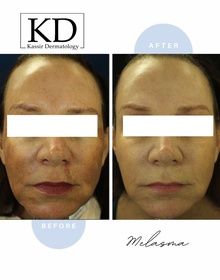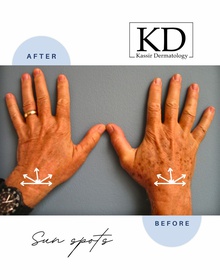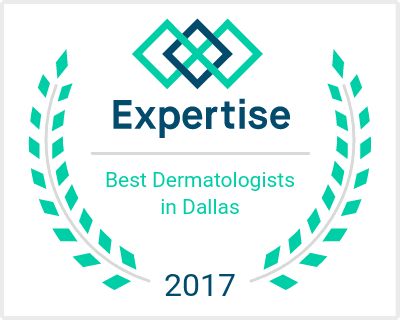
AGE SPOT TREATMENT

Kassir Dermatology offers premium treatments for age spots (seborrheic keratoses).
Age Spots (Seborrheic Keratoses) are non-cancerous growths that are usually brown but may vary in color from light brown to black. They also vary in size and can be a single growth or may occur in clusters. They appear waxy and have a "stuck on" look. These become more common with age. Seborrheic Keratoses are mostly found on the chest or back and may also be found on other parts of the body such as the face, neck and scalp.
Request More Info About
AGE SPOT TREATMENT
AGE SPOT TREATMENT IN DEPTH
by Martin Kassir, M.D., F.A.A.D.
Treatment may be done with cryosurgery or curettage. Curettage involves scraping these lesions from the skin surface. The area is numbed prior to this procedure with anesthetic. There is minimal bleeding and sutures are not required. Crusting occurs and the entire healing process usually takes one to two weeks.
Age Spot Treatment Before & After Gallery
Click here to see the age spot treatment gallery
aSKINg the EXPERT: Age Spot Treatment
What are Age Spots and how are they treated?
Commonly referred to as "Age Spots", seborrheic keratoses and lentigos are some of the most common dermatologic concerns of baby boomers. These are benign lesions and they can occur anywhere on the body. Seborrheic keratoses appear as "stuck on" waxy moles and can range in color from fleshy colored, yellow, gray, brown or even black. Lentigos are flat moles that appear light brown to black typically on sun exposed areas (face, hands, chest). Often a person visits their physician with a concern that their lesion could be cancerous. Sometimes people just want these lesions removed to maintain a youthful appearance. Baby boomers are demanding more treatment options for Seborrheic Keratoses as their population ages.
Seborrheic Keratoses are treated in a variety of ways. Curettage, topical therapy and freezing are all options depending on the location, size and number of lesions. Consult a board certified dermatologist for a proper diagnosis.
Are age spots cancerous?
Patients with "age spots" need to be evaluated but a Board Certified Dermatologist. What may look like an "age spot" to a patient may actually be a suspicious skin lesion. True "age spots" are non-cancerous lesions. They usually pose more of a cosmetic concern associated with aging for patients. Patients first need an evaluation (is it benign?), then a diagnosis (what type of age spot is it?), and finally a treatment plan (how to treat it). As age spots can vary, so does their treatment. Treatment may include topical therapy or medications, microdermabrasion, chemical peels, micro needling, curettage, IPL, lasers, or a combination of the above.
Kassir Dermatology © 2025









